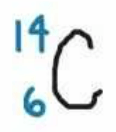BONUS - 700 points!
What are the 7 diatomic elements? (element symbols are fine, ALL OR NOTHING)
H, N, O, F, Br, Cl, I
What does the law of conservation of mass state?
Mass (or matter) cannot be created nor destroyed
"Paper is flammable" is an example of a....
a) Physical Property
b) Chemical Property
c) Physical Change
d) Chemical Change
b) Chemical Property
DOUBLE POINTS: All or nothing!
1) What are the three subatomic particles?
2) Which one has no essentially no mass?
1) proton, neutron, electron
2) electron
Quadruple points: All or nothing!
1) What element is 1s2 2s2 2p6 3s2 3p6?
2) Name an element in the same group.
3) Name an element in the same period.
4) Do elements in the same group or period have similar properties?
1) Argon
2) Helium, neon, krypton, xenon, radon
3) Na, Mg, Al, Si, P, S, Cl
4) Elements in the same GROUP have similar properties
Select the correct reaction: Mg + NaCl ->
a) Mg + NaCl -> MgCl + Na
b) Mg + 2 NaCl -> MgCl2 + 2 Na
c) Mg + NaCl -> NaMg + Cl
d) Mg + NaCl -> MgNaCl
b) Mg + 2 NaCl -> MgCl2 + 2 Na
Single replacement, metals can only replace metals
Balance the following reaction:
____ Zn + ____ Cl2 → ____ ZnCl3
__2__ Zn + ___3__ Cl2 → __2__ ZnCl3
What type of reaction is this?
NaCl + SrBr -> NaBr + SrCl
Double Replacement
An atom has 5 protons, 6 neutrons, and 4 electrons. What is its mass?
11 amu
Calculate the density of a block that has a mass of 6 g and a volume of 12 mL. INCLUDE THE CORRECT UNIT.
1) 0.5 g/mL
Predict the full reaction: FeCl3 →
a) FeCl3 → Fe + Cl3
b) 2 FeCl3 → 2 Fe + 3 Cl2
c) FeCl3 → Fe + Cl2
d) 2 FeCl3 → 3 Fe + 2 Cl3
b) 2 FeCl3 → 2 Fe + 3 Cl2
2 H2 + O2 -> 2 H2O
I start with 4.4 grams of hydrogen gas and 32 grams of oxygen gas. What mass of water should I produce?
36.4 grams (mass of reactants = mass of products)
What two products do combustion reactions ALWAYS have?
CO2 and H2O
(carbon dioxide and water)
Look at the atomic symbol below. (All or nothing)
1)What does the number 14 represent?
2)What does the number 6 represent?
3)How many neutrons does this isotope have?
1) mass (protons and neutrons)
2) atomic number/number of protons
3) 8 (subtract!)
Calculate the mass of an object that has a density of 1.9 g/mL and a volume of 0.4 mL. Round to the nearest 0.1 and include the correct unit.
0.8 g
Predict the correct full reaction for the following reactants: Rb + O2 →
a) 2 Rb + O2 → RbO2
b) Rb + O2 → RbO2
c) Rb + O2 → Rb2O
d) 4 Rb + O2 → 2 Rb2O
d) 4 Rb + O2 → 2 Rb2O
Na = 12 g
Cl = ?
NaCl = 30 g
18 g
Which of the following is a chemical change:
a) freezing water to make ice
b) heating up water
c) boiling or evaporating water
d) none of the above
Name the following:
1) NaBr
2) Li
3) Br2
1) Sodium Bromide
2) Lithium
3) Bromine
Calculate the average atomic mass for an unknown element whose isotopes have the following masses 23.985 amu (78.99%), 24.986 amu (10.00%), and 25.983 amu (11.01%). Round to the nearest 0.01 and include the correct UNIT.
24.31 amu
Aluminum metal reacts with sodium oxide in a single replacement reaction.
1) What is the formula of the compound that will be produced?
2) How do you know if aluminum replaces sodium or oxygen?
1) Al2O3
2) Metals replace metals
Balance the following reaction:
_ C2H4 + _ O2 → _ H2O + _ CO2
1, 3, 2, 2
Solid Sodium Hydroxide is decomposed to form solid sodium oxide and water vapor. Which indicator of chemical reactions is observed here?
a) formation of gas
b) unexpected color change
c) unexpected light
d) change in odor
e) precipitate formation
a) formation of gas
1) What kind of bond is in CaCl2?
2) What is the name of CaCl2?
3) What kind of bond is in N2O3?
4) What is the name of N2O3?
1) ionic
2) calcium chloride
3) covalent
4) dinitrogen trioxide
Rank the intermolecular forces from strongest to weakest: Dipole-Dipole, London Dispersion, Hydrogen Bonding